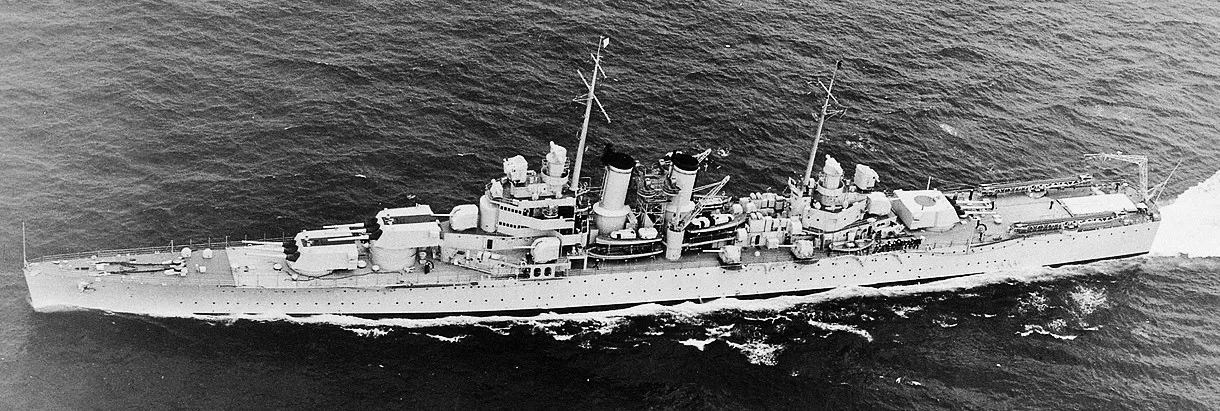Warships of the US Navy: Heavy Cruiser: USS Wichita (CA-45)
USN Heavy Cruiser USS Wichita (CA-45)
_and_USS_Wasp_(CV-7)_in_Scapa_Flow_in_April_1942.webp)
(USN Photo)
USS Wichita (CA-45) at anchor in Scapa Flow, Scotland (UK), in April 1942. The aircraft carrier USS Wasp (CV-7) is in the backgroun
USS Wichita (CA-45) was a unique heavy cruiser of the United States Navy built in the 1930s. The last American cruiser designed to meet the limits of the London Naval Treaty, she was originally intended to be a New Orleans-class heavy cruiser, accordingly with the maximum main armament of three triple 8-inch (203 mm) gun turrets. These were instead placed on an improved hull derived from the Brooklyn-class light cruisers, with increased armor. This design would go on to form the basis for the later Second World War–era heavy cruisers such as the Baltimore class. The ship was authorized by the 1929 Cruiser Act, laid down at the Philadelphia Naval Shipyard in October 1935, launched in November 1937, and commissioned into the US Navy in February 1939.Following her commissioning, Wichita was assigned to neutrality patrols in the Atlantic. After the United States entered World War II, the ship saw heavy service throughout the conflict. She was first assigned to convoy escort duty on the Murmansk Run in early 1942, and supported amphibious landings during Operation Torch in November 1942. During the Naval Battle of Casablanca, Wichita engaged several French coastal batteries and warships, including the battleship Jean Bart. In 1943, Wichita was transferred to the Pacific Theater, where she remained for the rest of the war. She frequently provided antiaircraft defense for the Fast Carrier Task Force during operations in the central Pacific, including the Battles of the Philippine Sea and Leyte Gulf in 1944. During the latter engagement, Wichita assisted in the sinking of the Japanese aircraft carrier Chiyoda.Wichita was heavily engaged during the invasion of Okinawa, where she provided heavy gunfire support to ground troops ashore. After the Japanese surrender, the ship served as part of the occupation force in Japan and assisted in the repatriation of American military personnel under Operation Magic Carpet. After returning to the United States, she was decommissioned and placed in the "mothball" fleet in 1947. She remained in reserve until 1959, when she was stricken from the Naval Vessel Register and sold for scrapping in August 1959. (Wikipedia)

(USN Photo)
USS Wichita (CA-45) operating in the Atlantic Ocean, out of Norfolk, Virginia, on 1 May 1940. Note the markings on her turret tops (bars on the forward turrets, a circle on the after turret). These scheme was used on several other heavy cruisers in 1939-40.

(USN Photo)
USS Wichita (CA-45) operating with the British Home Fleet, in the vicinity of Scapa Flow, Scotland, 22 April 1942.
_underway_during_a_winter_storm_off_Iceland_in_January_1942.webp)
(USN Photo)
USS Wichita (CA-45) rides out a winter storm off Iceland in mid-January 1942. Note the Consolidated PBY Catalina patrol plane on the deck of the seaplane tender from which the photograph was taken.
_underway_in_the_Central_Pacific_on_2_May_1944.webp)
(USN Photo)
USS Wichita (CA-45) underway at sea, 2 May 1944, during operations in the Central Pacific.

